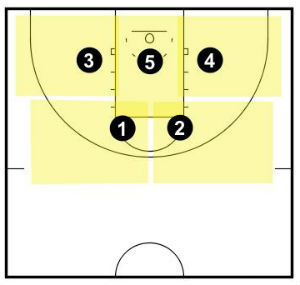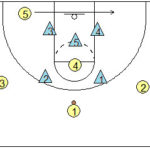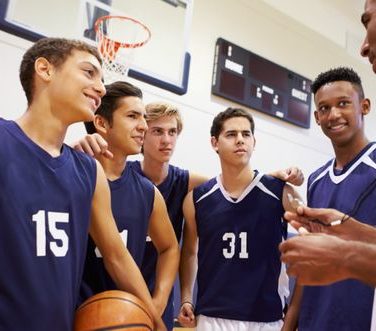
- 0
- 8.7K
- 0 likes
2-3 Youth Basketball Zone Defense
Different Types of Basketball Zone Defenses
Written By: Lamar Hull @ Inspirational Basketball AND Google+
There are a few different basketball variations of a basketball zone defense, one constant, regardless of its structure is the zone’s advantage over a man-to-man defense.
A basketball zone defense allows you to rely on players guarding specific areas versus guarding actually players, where a man-to-man defense can single out a weaker player and exploit that weakness. There are quite a few different zone defenses that are effective against a potent offense.
 The first and most common zone defense is a 2-3 zone. This consists of two guards at the top of the key, positioned at the elbows and three forwards down in the paint; 2 post players are on the blocks and 1 player guards the middle. This zone defense is critical when trying to protect the paint.
The first and most common zone defense is a 2-3 zone. This consists of two guards at the top of the key, positioned at the elbows and three forwards down in the paint; 2 post players are on the blocks and 1 player guards the middle. This zone defense is critical when trying to protect the paint.
This is often used late in the game to protect your team from giving up an easy basket or lay up. If your team isn’t a great man-to-man defensive unit, then the zone defense should utilized throughout the course of the game. Having three big men down low in the box enables your team to better secure rebounds in late game situations.
If you talk to any coach, they will tell you that any zone defense takes great communication and constant chatter between the players. To understand who will be grabbing the rebound, to understanding which player needs to close off the lane to the hoop, players have to be hyper active and great communicators within the zone.
Without constant communication the zone will collapse and your team will be forced in to a man-to-man.
The second basketball zone defense is the 3-2 zone defense which involves a similar approach but for the opposite reason. This defense involves three guards and two big men down low.
This defense is primarily used to defend against the three point shot and to pressure the outside shooters more. This defense is highly effective, by having your guards constantly rotate at the top and having your players’ hands up and fully extended gives the offense a cluttered and stressful environment.
Any zone defense has a weakness if the offense can get the ball into the middle of the paint where the defense is susceptible to a mid range jumper. If the basketball enters the middle of the paint, the defense is forced to adjust by protecting the rim, providing the offense with a kick out.
With constant communication on the court between the defenders, you can definitely make an offense uncomfortable. If the young players are aware of their zone responsibilities, it is very hard to be successful against a quality opponent running the 3-2.
 The third and final zone defense that I like is the 1-2-2 zone defense. This is the middle ground in my mind to the 2-3 and the 3-2 zone defenses.
The third and final zone defense that I like is the 1-2-2 zone defense. This is the middle ground in my mind to the 2-3 and the 3-2 zone defenses.
You will have two men at the top of the key and two men at the bottom of the zone, along with one man up top who roams around guarding the outside shot, but should also versatile enough to grab a rebound when needed. The player at the top of the key should be long, so that you can force the offense to make long top of the key passes.
Sometimes it is beneficial to put your bigger and longer player at the top of the 1-2-2 youth zone defense. This often is dependent upon the type of team you have, some teams just do not have the ability, skill, length and quickness to run the 1-2-2.
This zone defense is great against teams that run a lot of ball screens and shoot the basketball at a high percentage. If ran correctly it alleviates almost any threat and relies on the theory of defending your area.
Final note, which I have discussed in this entire article, players have to communicate with each other and do not allow penetration into the lane when playing in a zone defense.
If all those are done properly this type of defense can be a very difficult task to overcome for even the most potent of offenses. Syracuse always play unbelievable zone defenses that forces teams to play out of the comfort zone.








LEAVE A COMMENT